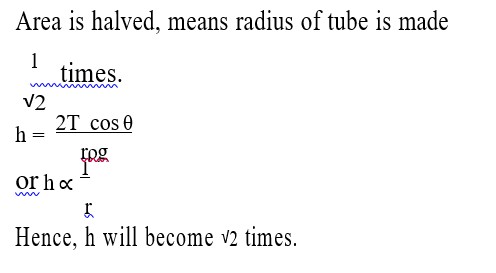13.13 A gas in equilibrium has uniform density and pressure throughout its volume. This is strictly true only if there are no external influences. A gas column under gravity, for example, does not have uniform density (and pressure). As you might expect, its density decreases with height. The precise dependence is given by the so-called law of atmospheres
n2 = n1 exp [ -mg (h2 – h1)/ kBT]
where n2, n1 refer to number density at heights h2 and h1 respectively. Use this relation to derive the equation for sedimentation equilibrium of a suspension in a liquid column:
n2 = n1 exp [ -mg NA
( - ) (h2 –h1)/ ( RT)]
where is the density of the suspended particle, and that of surrounding medium. [NA is Avogadro’s number, and R the universal gas constant.] [Hint : Use Archimedes principle to find the apparent weight of the suspended particle.]
13.13 A gas in equilibrium has uniform density and pressure throughout its volume. This is strictly true only if there are no external influences. A gas column under gravity, for example, does not have uniform density (and pressure). As you might expect, its density decreases with height. The precise dependence is given by the so-called law of atmospheres
n2 = n1 exp [ -mg (h2 – h1)/ kBT]
where n2, n1 refer to number density at heights h2 and h1 respectively. Use this relation to derive the equation for sedimentation equilibrium of a suspension in a liquid column:
n2 = n1 exp [ -mg NA ( - ) (h2 –h1)/ ( RT)]
where is the density of the suspended particle, and that of surrounding medium. [NA is Avogadro’s number, and R the universal gas constant.] [Hint : Use Archimedes principle to find the apparent weight of the suspended particle.]
-
1 Answer
-
13.13 According to law of atmospheres, we have
n2 = n1 exp [ -mg (h2 – h1)/ kBT] ….(i)
where is the number of density at height and is the number of density at height
mg is the weight of the particle suspended in the gas column
Density of the medium =
Density of the suspended particle =
Mass of one suspended particle = m'
Mass of medium displaced = m
Volume of the suspended particle = V
According to Archimedes's principle for a particle suspended in a liquid column, the effective weight of the suspended particle is given as:
Weight of the medium displaced – weight of the suspended particle = mg – m'g
= mg- V = mg –
...more
Taking an Exam? Selecting a College?
Get authentic answers from experts, students and alumni that you won't find anywhere else
Sign Up on ShikshaOn Shiksha, get access to
- 65k Colleges
- 1.2k Exams
- 679k Reviews
- 1800k Answers



